All You Need to Know About Medina Marrakech Old Town
Marrakech, the vibrant heart of Morocco, is famous for its rich history, stunning architecture, and bustling souks. At the center of it all lies the Medina Marrakech, the old town, a UNESCO World Heritage Site that has preserved its charm for centuries. Whether you’re a history buff, a food lover, or an adventure seeker, Medina Marrakech has something for everyone. This guide covers everything you need to know about Marrakech Old Town, from its history and must-visit spots to where to eat, shop, and stay.
Where is Medina Marrakech?
The Medina Marrakech Morocco is the historical center of Marrakech, a city located in the western part of Morocco. The Medina, surrounded by ancient walls, is a maze of narrow alleys, traditional markets, and stunning riads. It is easily accessible from the main parts of the city, with key landmarks like Jemaa el-Fnaa Square, Koutoubia Mosque, and Bahia Palace nearby.

A map displaying the location of the Medina in Marrakech.
How to Get There?
- From Marrakech Menara Airport, it takes around 15–20 minutes by taxi.
- Public buses and private transfers are also available.
- Many travelers prefer to stay in Medina Marrakech hotels, making it easier to explore on foot.
How Old is Marrakech Medina?
The Marrakech Medina dates back to 1070, when it was founded by the Almoravids. Over the centuries, it has been a hub for trade, culture, and politics. The city’s architecture reflects a blend of Berber, Arab, and Andalusian influences, making it one of the most fascinating historical sites in Morocco.

A glimpse into the historic architecture of Medina.
Some of the Medina’s iconic landmarks, like the Koutoubia Mosque and Ben Youssef Madrasa, have stood the test of time, showcasing the city’s rich heritage.
How Big is the Medina in Marrakech?
The Medina spans approximately 600 hectares (1,500 acres), making it one of the largest historic centers in North Africa.
Key Areas Within the Medina:
- Jemaa el-Fnaa: The main square filled with street performers, food stalls, and vibrant energy.
- The Souks: A labyrinth of markets selling everything from spices to leather goods.
- The Kasbah: A quieter area with palaces and mosques.
- The Jewish Quarter (Mellah): Known for its historical significance and synagogues.
Navigating the Medina can be challenging, so having a Marrakech old town map or using a GPS-enabled phone is highly recommended.
Medina Marrakech Things to Do
There are endless things to do in the Medina, but here are the must-visit spots:
1. Visit Jemaa el-Fnaa
This lively square is the beating heart of Marrakech, filled with snake charmers, henna artists, and food vendors.
2. Explore the Souks
The Marrakech old town market is a paradise for shoppers looking for authentic Moroccan goods like carpets, ceramics, and traditional clothing.
3. Admire the Koutoubia Mosque
The largest mosque in Marrakech, its minaret dominates the skyline.
4. Discover the Bahia Palace
A stunning example of Moroccan architecture with beautiful courtyards and intricate tilework.
5. Experience a Traditional Hammam
A visit to a local hammam (bathhouse) is a unique Moroccan experience that combines relaxation and deep cleansing.
Marrakech Old Town Market: A Shopper’s Paradise

A lively scene from the Marrakech old town market.
The Marrakech Medina is home to some of the most famous souks (markets) in the world. Each souk specializes in different goods, creating an unforgettable shopping experience.
Popular Souks in the Medina:
- Souk Semmarine: Clothing, jewelry, and home décor.
- Souk el Attarine: Spices, perfumes, and medicinal herbs.
- Souk Haddadine: Traditional metalwork and lanterns.
Shopping Tips:
- Bargaining is expected! Start by offering half of the initial price.
- Visit in the morning for a quieter experience.
- Be cautious of fake souvenirs and always check product quality.
Medina Marrakech Restaurants: A Culinary Journey

Experience the delicious cuisine of Marrakech.
Food lovers will find plenty to indulge in at Medina Marrakech restaurants. Traditional Moroccan cuisine is full of bold flavors, aromatic spices, and slow-cooked dishes.
Top Restaurants in the Medina:

A must-visit rooftop restaurant in Medina Marrakech.
- Nomad Marrakech: A trendy rooftop restaurant offering modern Moroccan dishes with a twist.
- Café des Épices: Perfect for light meals and fresh juices.
- Le Jardin: A hidden gem with a beautiful green courtyard.
Must-Try Dishes:
- Tagine: A slow-cooked stew with meat, vegetables, and spices.
- Couscous: Morocco’s national dish, often served on Fridays.
- Pastilla: A sweet and savory pastry filled with chicken or seafood.
Medina Marrakech Hotels: Where to Stay

Stay in a traditional riad hotel in the Medina.
The best way to experience Marrakech Old Town is by staying in a traditional riad—a guesthouse with an inner courtyard.
Recommended Riads and Hotels:
- Riad Yasmine: A picturesque boutique riad with a beautiful pool.
- La Mamounia: A luxury hotel with stunning gardens.
- Riad Be Marrakech: A cozy, Instagram-worthy stay.
Staying inside the Medina allows you to be within walking distance of major attractions and markets.
Medina Opening Hours: When to Visit
The Medina Marrakech is open 24/7, but specific attractions, shops, and restaurants have their own operating hours.
General Opening Hours:
- Souks: 9 AM – 9 PM
- Jemaa el-Fnaa: Most lively in the evening
- Museums & Palaces: 9 AM – 5 PM
The best time to visit is early in the morning or late afternoon to avoid the intense midday heat.
Medina Marrakech at Night: The Evening Charm

The magical atmosphere of Medina Marrakech after dark.
At night, the Medina transforms into a magical world of glowing lanterns, bustling food stalls, and live entertainment.
Things to Do at Night:
- Dine at Nomad Marrakech or Café Arabe.
- Enjoy live music at Le Comptoir Darna.
- Experience the vibrant street performances in Jemaa el-Fnaa.
The Medina is generally safe at night, but it’s best to stick to well-lit areas and avoid empty alleys.
How Much is a Taxi from Marrakech Airport to Medina?

Find out the cost of a taxi from Marrakech airport to Medina.
A taxi from Marrakech Menara Airport to the Medina costs around 100–150 MAD (€10–15) during the day and 150–200 MAD (€15–20) at night.
Taxi Tips:
- Always negotiate the fare before getting in.
- Use official taxis or book through your hotel.
- Consider a private airport transfer for convenience.
Medina Old Town Marrakech: Hidden Gems

Le Jardin Secret Marrakech
Beyond the main attractions, here are some hidden gems to explore:
- Dar Si Said Museum: A quiet spot showcasing Moroccan arts.
- Photography Museum: Offers a glimpse into the history of Marrakech.
- Le Jardin Secret: A peaceful oasis amid the bustling souks.
Old Town Marrakech: Cultural Insights
The Medina Marrakech Morocco is a cultural treasure trove. Here are some local customs to keep in mind:
- Dress modestly, especially in religious sites.
- Always greet with “Salam Alaikum” when entering shops.
- Try mint tea—it’s a symbol of hospitality.

Experience the vibrant culture of Medina Marrakech
Conclusion
Visiting Marrakech is an unforgettable experience filled with history, culture, and adventure. Whether you’re exploring the Marrakech old town market, staying in a traditional riad, or enjoying Moroccan cuisine, the Medina offers something for everyone. Be prepared to get lost in its charm, and embrace the beauty of this magical place
Marrakech Medina FAQs
What is Marrakech Medina Old Town known for?
Marrakech Medina Old Town is renowned for its rich history, vibrant culture, and stunning architecture. It’s a UNESCO World Heritage site and the heart of Marrakech’s traditional and cultural identity.
What are the must-visit historical landmarks in Marrakech Medina?
Explore iconic landmarks like the Koutoubia Mosque, Bahia Palace, Saadian Tombs, and the historic Ben Youssef Madrasa within Medina.
Are there traditional markets in Marrakech Medina Old Town?
Yes, Marrakech Medina is famous for its bustling souks, offering a wide range of goods from spices and textiles to handmade crafts. The Souks are a treasure trove for shoppers.
How do I navigate the narrow alleys of the Medina?
Navigating the Medina’s labyrinthine alleys can be challenging. Consider hiring a local guide for a more immersive experience, or use landmark references to find your way.
What are Riads, and can I stay in one in the Old Town?
Riads are traditional Moroccan houses with interior courtyards. Many Riads in the Old Town have been converted into accommodations, offering an authentic stay amidst the cultural hub.
What is the best time to visit Marrakech Medina Old Town?
Spring (March to May) and fall (September to November) are ideal. The weather is mild, and the city comes alive with blooming flowers and cultural events.
Are there specific dress codes to follow in Medina?
While there isn’t a strict dress code, it’s advisable to dress modestly, especially when visiting religious sites. Comfortable and breathable clothing is recommended for navigating the Medina.
What transportation options are available within the Old Town?
Traditional modes of transport include horse-drawn carriages and walking. The narrow streets make them more suitable than modern vehicles. Taxis can be used at the outskirts.
Can I experience Moroccan cuisine in the Old Town?
Absolutely! Marrakech Medina is a culinary delight. You can enjoy traditional Moroccan cuisine in local eateries and street food stalls.
Are there safety measures I should be aware of in the Old Town?
Exercise caution in crowded areas, secure your valuables, and be aware of your surroundings. Familiarize yourself with emergency contacts and services.

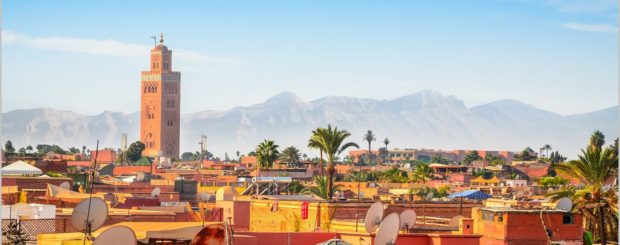

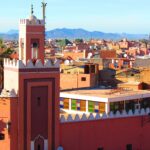
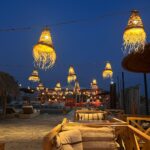
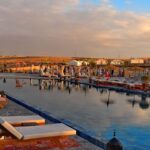
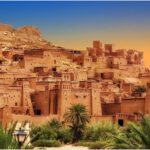





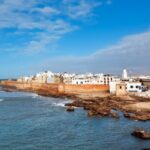
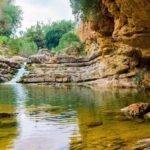



hi there! thank you for sharing your tips with us about this amazing experience in Marrakesh! I love the first photo about Medina (with the mountains on the back), would u mind if I ask u from where you got this amazing view? was it from any rooftop bar? tk u in advance!
Hello Bruna,
Thanks for your comment,
Regarding the view of the Medina and the Atlas Mountains that you saw in the first photo, the best place to see this view is from the rooftop terrace of a riad or hotel located in the Medina. Some popular options include La Mamounia, Riad BE Marrakech, Le Jardin Secret, El Fenn, and Café des Épices.
For the best sunset view, I would recommend going to the Jemaa el-Fna square. This lively square is the heart of Medina; some cafes nearby such as Café de France, Café glacier… offer a stunning view of the sunset over the Koutoubia Mosque.